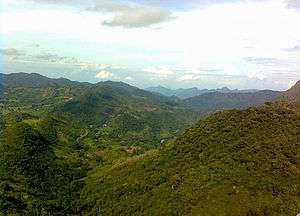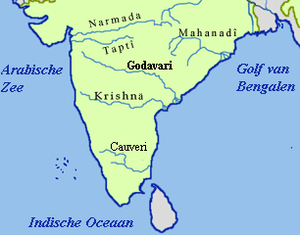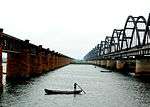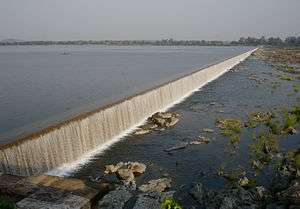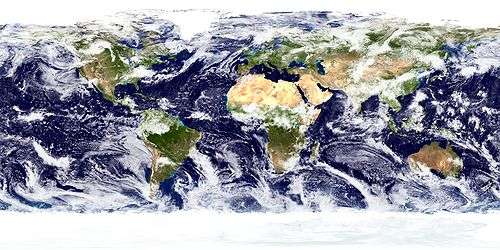Eastern Ghats
| Eastern Ghats | |
|---|---|
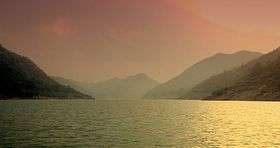 | |
| Highest point | |
| Peak | Jindhagada[1] (Andhra Pradesh, India) |
| Elevation | 1,680 m (5,510 ft) |
| Prominence | 1,290 m (4,230 ft) |
| Geography | |
| Country | India |
| States | |
| Regions | Eastern India and South India |
| Settlement | |
| Biome | Forests |
| Geology | |
| Type of rock | Igneous, Iron and Limestone |
The Eastern Ghats are a discontinuous range of mountains along India's eastern coast. The Eastern Ghats run from the northern Odisha through Andhra Pradesh to Tamil Nadu in the south passing some parts of Karnataka and in the Wayanad region of Kerala. They are eroded and cut through by four major rivers of peninsular India, viz. Godavari, Mahanadi, Krishna, and Kaveri.
The mountain ranges run parallel to the Bay of Bengal. The Deccan Plateau lies to the west of the range, between the Eastern Ghats and Western Ghats. The coastal plains, including the Coromandel Coast region, lie between the Eastern Ghats and the Bay of Bengal. The Eastern Ghats are not as high as the Western Ghats.
Geography
The Eastern Ghats are older than the Western Ghats, and have a complex geologic history related to the assembly and breakup of the ancient supercontinent of Rodinia and the assembly of the Gondwana supercontinent.
The Eastern Ghats are made up of charnockites, granite gneiss, khondalites, metamorphic gneisses and quartzite rock formations. The structure of the Eastern Ghats includes thrusts and strike-slip faults[2] all along its range. Limestone, bauxite and iron ore are found in the Eastern Ghats hill ranges.
The Eparchaean Unconformity of the Tirumala Hills is a major discontinuity of stratigraphic significance that represents an extensive period of erosion and non-deposition. It is seen at the steep natural slopes, road scars and ravines in the Tirumala ghat roads in the Chittoor district of Andhra Pradesh.[3][4]
Hill ranges
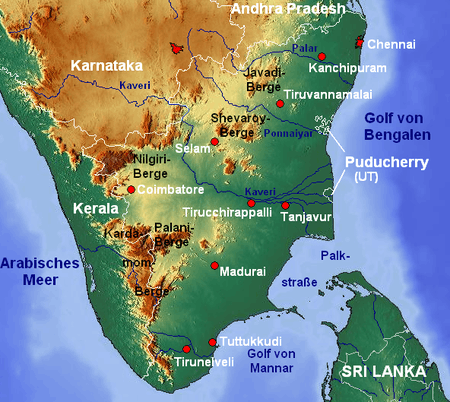
As with the Western Ghats, these mountain ranges also have local names along the discontinuous hill ranges.
At their southern end, the Eastern Ghats form several ranges of low hills. The southernmost of the Eastern Ghats are the low Sirumalai and Karanthamalai Hills of southern Tamil Nadu.
North of the Kaveri River are the higher Kollimalai, Pachaimalai, Shevaroy (Servarayan), Kalrayan Hills, Chitteri, Javadhu Hills, Palamalai and Mettur Hills in northern Tamil Nadu state. The climate of the higher hill ranges is generally cooler and wetter than the surrounding plains, and the hills are home to coffee plantations and enclaves of dry forest.
The hill station of Yercaud is located in the Shevaroy Hills. The Biligiriranga Hills, which run east from the Western Ghats to the River Kaveri, form a forested ecological corridor that connects the Eastern and Western Ghats, and allows the second-largest wild Asian elephant population in India to range between the South Eastern Ghats, the Biligiriranga Hills and Nilgiri Hills, and the South Western Ghats.
The Male Mahadeshwara Hills Temple is situated in Chamarajanagar district in Karnataka state in the Eastern Ghats.
The Ponnaiyar and Palar rivers flow from headwaters on the Kolar Plateau eastward through gaps in the Ghats to empty into the Bay of Bengal; the Javadhu Hills lie between the two rivers. There are waterfalls in remote areas, such as the Kiliyur Falls.[5]
North of the Palar River in Andhra Pradesh, the central portion of the Eastern Ghats consists of two parallel ranges running approximately north-south. The lower Velikonda Range lies to the east, and the higher Palikonda-Lankamalla-Nallamalai Ranges lie to the west. They run in a nearly north-south alignment, parallel to the Coromandel Coast for close to 430 km between the Krishna and Pennar rivers. Its northern boundaries are marked by the flat Palnadu basin, while in the south it merges with the Tirupati hills. An extremely old system, the hills have been extensively weathered and eroded over the years. The average elevation today is about 520 m, but reaches 1,100 m at Bhairani Konda and 1,048 m at Gundla Brahmeswara.
The Tirumala Hills are located along the Seshachalam-Velikonda Range of the Eastern Ghats. The Palar River cuts through the ranges. The Velikonda Range eventually descends to the coastal plain in northern Nellore district, while the Nallamalla Range in Kurnool continues to the River Krishna.
The Kondapalli Hills are a range of low hills which lie between the Krishna and the Godavari rivers. These hills are located in the Guntur, Krishna, West Godavari and Khammam districts of Andhra Pradesh. The Krishna River bisects these hills of the Eastern Ghats. The main hill range starts from Nandigrama to Vijayawada known as Kondapalli.
The Papi Hills (Papi Kondalu) are distributed among the Khammam, East Godavari and West Godavari districts of Andhra Pradesh and lie in the Eastern Ghats.
Madhurawada Dome in the Eastern Ghats mobile belt is formed by a tectonic arrangement with the khondalite suite and quartz Archean rocks along the Eastern Ghats north of Visakhapatnam.[6]
The Maliya Range is located in the northern portion of the Eastern Ghats. The Maliya Range generally ranges between elevations of 900–1200 m, although some of its summits soar higher. The tallest peak in this range is Mahendragiri (1,501 m).[7]
The Madugula Konda Range is located in the northern portion of the Eastern Ghats. The Madugula Konda range is higher than the Maliyas and generally ranges between elevations of 1100–1400 m. Prominent summits include the highest peak of the Eastern Ghats - Arma Konda (1680 m), Gali Konda (1643 m) and Sinkram Gutta (1620 m).[7]
The highest mountain peak in the state of Odisha is Deomali (1672 m), which is situated in the Koraput district of southern Odisha. It is part of the Chandragiri-Pottangi mountain system. The region covers about three-fourths of the entire Odisha state. Geologically it is a part of the Indian Peninsula which was a part of the ancient land mass of Gondwanaland. The major rivers of Odisha with their tributaries have cut deep and narrow valleys.
The Garhjat Range is a northeastern prolongation of the eastern Ghats which rises abruptly and steeply in the east and slopes gently to a dissected plateau in the west running from north-west (Mayurbhanj) to south-west (Malkangiri). The Odisha highlands are also known as the Garhjat Hills. This region is well marked by a number of interfluves or watersheds which interrupt the terrain in the form of broad and narrow river valleys and flood plains. The average height of this region is about 900 metres above mean sea level.
The Similipal massif is considered the farthest northeast extension of the Eastern Ghats.[8]
Rivers
The Eastern Ghats are the source points for many small and medium rivers[9] along the east coastal plains of South India.
Rivers flowing through Eastern Ghats include:
Rivers originating on the Eastern Ghats include:
Fauna
The endemic fauna of the Eastern Ghats are the Jerdon's courser (Rhinoptilus bitorquatus) and grey slender loris (Loris lydekkerianus). The rare geckos[10] found here are the Indian golden gecko (Calodactylodes aureus), rock gecko (Hemiphyllodactylus aurantiacus), and Sharma's skink (Eutropis nagarjuni).
Mammals
Indian elephant (Elephas maximus indicus), blackbuck (Antilope cervicapra), Asian palm civet (Paradoxurus hermaphroditus), small Indian civet (Viverricula indica), Madras treeshrew (Anathana ellioti), common grey mongoose (Herpestes edwardsii), sambar deer (Rusa unicolor), Indian crested porcupine (Hystrix indica), Indian bison (Bos gaurus), wild boar (Sus scrofa), common muntjac (Muntiacus muntjak), Indian leopard (Panthera pardus fusca), Bengal tiger (Panthera tigris tigris), dhole (Cuon alpinus), golden jackal (Canis aureus), Indian giant squirrel (Ratufa indica), Indian hare (Lepus nigricollis), Asian house shrew (Suncus murinus), tufted grey langur (Semnopithecus priam), Indian flying fox (Pteropus giganteus), bonnet macaque (Macaca radiata), rhesus macaque (Macaca mulatta), Bengal fox (Vulpes bengalensis), smooth-coated otter (Lutrogale perspicillata), jungle cat (Felis chaus), cheetal (Axis axis), striped hyena (Hyaena hyaena), Indian mole-rat (Bandicota bengalensis)[11]
Birds
Great Indian bustard (Ardeotis nigriceps), red-wattled lapwing (Vanellus indicus), spot-billed pelican (Pelecanus philippensis), blue peafowl (Pavo cristatus), Indian pond heron (Ardeola grayii), hoopoe (Upupa epops), spotted owlet (Athene brama), greater coucal (Centropus sinensis), pied crested cuckoo (Clamator jacobinus), Oriental white ibis (Threskiornis melanocephalus), Indian pitta (Pitta brachyura), Indian paradise flycatcher (Terpsiphone paradisi), red-vented bulbul (Pycnonotus cafer), red-whiskered bulbul (Pycnonotus jocosus), jungle babbler (Turdoides striata), painted stork (Mycteria leucocephala), black-rumped flameback (Dinopium benghalense), brahminy kite (Haliastur indus), jungle myna (Acridotheres fuscus), Indian spotted eagle (Aquila hastata), Indian vulture[12] (Gyps indicus)[13], Malabar whistling thrush (Myophonus horsfieldii)
Amphibians
Up to 30 species of amphibians including the Gunther's toad (Bufo hololius), pond frogs (Euphlyctis), cricket frog (Fejervarya), bull frogs (Hoplobatrachus), burrowing frogs (Sphaerotheca), balloon frogs (Uperodon), small-mouthed frogs (Microhyla), and tree frog (Polypedates) occur here. Endemic ones include the golden-backed frogs (Hylarana spp.), the bush frog Raorchestes terebrans and the recently described caecilian Gegeneophis orientalis and an Ichthyophis species that is known from old records.[14][15]
Reptiles
Nearly 100 species of reptiles occur in the Eastern Ghats. Many endangered species are also present, including the mugger crocodile (Crocodylus palustris), Indian black turtle (Melanochelys trijuga), Indian flapshell turtle (Lissemys punctata), Indian tent turtle (Pangshura tentoria), Indian star tortoise (Geochelone elegans), Leith's softshell turtle (Nilssonia leithii), many of which are found in the northern rivers and riverine valley tracts.
Among lizards are the Roux's forest calotes Calotes rouxii, those of the genera (Psammophilus ), (Sitana), Indian chameleon (Chamaeleo zeylanicus), Reticulated gecko (Hemidactylus reticulatus), the rock geckoes Hemidactylus giganteus, Hemidactylus graniticolus, the golden gecko (Calodactylodes aureus), the slender gecko (Hemiphyllodactylus aurantiacus), the rare ground geckoes (Cyrtodactylus nebulosus), (Cyrtodactylus collegalensis), the recently rediscovered (Geckoella jeyporensis), Leschenault's snake-eye (Ophisops leschenaultii), Blinking snake-eye (Ophisops minor), Ashwamedh's skink (Eutropis ashwamedhii), Beddome's skink Eutropis beddomei, Nagarjun's skink (Eutropis nagarjuni) and Bengal monitor (Varanus bengalensis). Noteworthy lizards include the endemic, fossorial genera of leg-less skinks such as Sepsophis punctatus, Barkudia melanosticta and Barkudia insularis that are known only from the northern ranges and along the adjoining Eastern coastal plains in northern Andhra Pradesh and Odisha.
Among snakes are the beaked worm snake (Grypotyphlops acutus), the endemic shield-tailed snakes like Uropeltis ellioti, Uropeltis shorttii, the recently described Rhinophis goweri, the endangered Indian rock python (Python molurus), Forsten's cat snake (Boiga forsteni), yellow-green cat snake (Boiga flaviviridis), Srilankan flying snake (Chrysopelea taprobanica), Nagarjun Sagar racer (Coluber bholanathi), green keelback (Macropisthodon plumbicolor), Duméril's black-headed snake (Sibynophis subpunctatus), Indian reed snake (Liopeltis calamaria). Apart from the Big Four Indian venomous snakes, endemic ones like the Beddome's coral snake (Calliophis beddomei) and the Indian green Bamboo pit viper (Trimeresurus gramineus) and the rare King cobra (Ophiophagus hannah) and the Banded krait (Bungarus fasciatus) are also known from parts of this region.[14][15]
Protected areas
Sanctuaries and national parks of the Eastern Ghats:
- Coringa Wildlife Sanctuary, Andhra Pradesh
- Hadgarh Wildlife Sanctuary, Odisha
- Kambalakonda Wildlife Sanctuary, Andhra Pradesh
- Krishna Wildlife Sanctuary, Andhra Pradesh
- Koundinya Wildlife Sanctuary, Andhra Pradesh
- Lakhari Valley Wildlife Sanctuary, Odisha
- Nagarjunsagar-Srisailam Tiger Reserve, Andhra Pradesh and Telangana
- Papikonda Wildlife Sanctuary, Andhra Pradesh
- Rollapadu Bird Sanctuary, Andhra Pradesh
- Satkosia Tiger Reserve, Odisha
- Simlipal National Park, Odisha
- Sri Lankamalleswara Wildlife Sanctuary, Andhra Pradesh
- Sri Venkateswara National Park, Andhra Pradesh
- Sunabeda Tiger Reserve, Odisha
- Vedanthangal Bird Sanctuary, Tamil Nadu
According to a study published in 2018, the forest cover of the Eastern Ghats has shrunk drastically since 1920 and several plant species endemic to this region face the threat of extinction[16].
See also
References
- ↑ Kenneth Pletcher (August 2010). The Geography of India: Sacred and Historic Places. The Rosen Publishing Group, 2010. pp. 28–. ISBN 978-16-1530-142-3. Retrieved 4 July 2013.
- ↑ "Geology of Eastern Ghats in Andhra Pradesh" (PDF). Proceedings of the Indian Academy of Sciences, Section B. 66 (5): 200–205. November 1967. doi:10.1007/BF03052185.
- ↑ "Eparchaean Unconformity, Tirumala Ghat section". Geological Survey of India. Archived from the original on 2013-04-19. Retrieved 2009-09-20.
- ↑ Geological Monuments of India. Eparchaean Unconformity (Tirupati Tirupati Road). Geological Survey of India. 2001. pp. 5–8.
- ↑ "Jungle Look". Chennai, India: The Hindu. 2006-02-11. Retrieved 2006-12-09.
- ↑ Jagadeeswara Rao, P.; Harikrishna, P.; Srivastav, S.K.; Satyanarayana, P.V.V.; Vasu Deva Rao, B. (October 2009). "Selection of groundwater potential zones in and around Madhurawada Dome, Visakhapatnam District - A GIS approach" (PDF). J. Ind. Geophys. Union. 13 (4): 191–200. Retrieved 4 April 2014.
- 1 2 M.S. Kohli (August 2010). Mountains of India: Tourism, Adventure and Pilgrimage. Indus Publishing, 2014. pp. 36–. ISBN 978-81-7387-135-1. Retrieved 4 July 2013.
- ↑ "National Biodiversity Strategy and Action Plan profiles the Eastern Ghats of southern India" originally from http://sdnp.delhi.nic.in/nbsap/dactionp/ecoregion/eghatdraft.html%5Bpermanent+dead+link%5D
- ↑ Flora of Eastern Ghats: Hill Ranges of South East India - Thammineni Pullaiah, D. Muralidhara Rao, K. Sri Ramamurthy - Google Books. Books.google.co.in. Retrieved on 2013-07-28.
- ↑ "Archived copy" (PDF). Archived from the original (PDF) on 2012-11-01. Retrieved 2013-06-19.
- ↑ No.1,2006.pdf The Eastern Ghats. Archive of No.1,2006.pdf original site
- ↑ Endangered vultures sighted in Raichur. The Hindu (2012-08-29). Retrieved on 2013-07-28.
- ↑ Critically endangered vulture found in Adilabad district. The Hindu (2013-06-05). Retrieved on 2013-07-28.
- 1 2 Srinivasulu, C., & Das, I. (2008). The herpetofauna of Nallamala Hills, Eastern Ghats, India: an annotated checklist, with remarks on nomenclature, taxonomy, habitat use, adaptive types and biogeography. Asiatic Herpetological Research, 11, 110-131.
- 1 2 Ganesh, S. R., & Arumugam, M. (2015). Species Richness of Montane Herpetofauna of Southern Eastern Ghats, India: A Historical Resume and a Descriptive Checklist. Russian Journal of Herpetology, 23(1), 7-24.
- ↑ Pacha, Aswathi (2018-10-06). "Eastern Ghats face loss of forest cover, endemic plants". The Hindu. ISSN 0971-751X. Retrieved 2018-10-13.
| Wikimedia Commons has media related to Eastern Ghats. |
